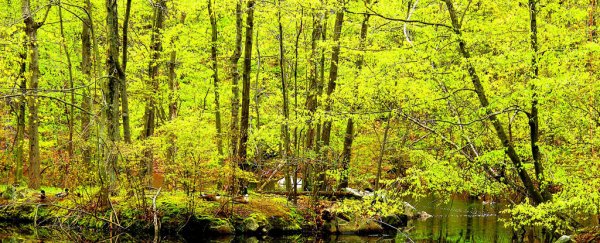We're used to hearing about how rising carbon dioxide (CO2) levels in the atmosphere are leading to things like higher temperatures and dangerous pollution, but there's another, less commonly understood consequence to today's era-defining CO2 peak.
An international team of scientists has studied 33 years of satellite data and found that Earth is actually getting significantly greener as a result of rising carbon dioxide levels, with greater carbon emissions over the past three decades leading to a huge increase in the amount of leaves on plants and trees.
"We were able to tie the greening largely to the fertilising effect of rising atmospheric CO2 concentration by tasking several computer models to mimic plant growth observed in the satellite data," said researcher Ranga Myneni from Boston University.
But how are airborne pollutants spurring vegetation growth? The process, called the carbon fertilisation effect, results from leaves absorbing CO2 from the air as part of photosynthesis. With greater levels of carbon in the atmosphere, plants and trees and even crops actually grow faster, particularly in warm climates.
And with the levels of carbon in the atmosphere as high as they are now, that's seen a massive increase in the amount of vegetation over the surface of the planet.
"The greening over the past 33 years reported in this study is equivalent to adding a green continent about two times the size of mainland USA (18 million km2), and has the ability to fundamentally change the cycling of water and carbon in the climate system," said one of the team, Zaichun Zhu from Peking University in China.
As a result of the growth in recent decades, vegetation now covers almost a third (32 percent) of the planet's total surface area, occupying about 85 percent of all ice-free land.
But while extra greenery – and its ability to absorb atmospheric carbon – sounds like a positive for the environment, the scientists warn that this side effect of high carbon levels will only be temporary, and won't ultimately help against other consequences of climate change, such as severe weather, and rising temperatures and sea levels.
"[S]tudies have shown that plants acclimatise, or adjust, to rising CO2 concentration and the fertilisation effect diminishes over time," said Philippe Ciais from the Laboratory of Climate and Environmental Sciences in France.
Nor is CO2 the only factor behind the current green trends. The scientists say nitrogen use in agricultural fertilisers, climate change generally, and land management also contribute to the phenomenon in lesser amounts.
The findings, reported in Nature Climate Change, will hopefully serve as another pressing reminder of the importance of lowering carbon emissions, in the same week that world leaders have come together to sign the Paris climate deal.
"This is a snapshot of humans' global influence on the functioning of the entire global biosphere," one of the team, Pep Canadell from the CSIRO in Australia, told Anna Salleh at the ABC. "The growth of CO2 in the atmosphere is almost exclusively due to fossil fuel burning and deforestation."
